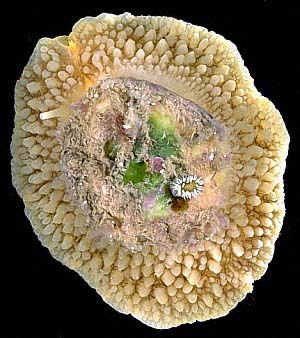
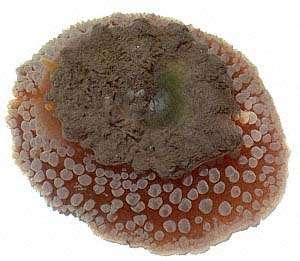
Umbraculum umbraculum
(Lightfoot, 1786)
Order: NOTASPIDEA
Superfamily: TYLODINOIDEA
Family: Umbraculidae
DISTRIBUTION
Widespread in tropical to warm temperate Indo-West Pacific.
PHOTO
UPPER: Shelly Beach, Manly, Sydney, NSW, Australia, 3 metres, September 1986. 14cm long.
LOWER: Dar es Salaam, Tanzania, July 1974. 12cm long.
PHOTOS: Bill Rudman.
A primitive notaspid, with a large external shell covering the dorsum. The shell, as in both these photos, is usually covered with encrusting plant and animal growths. The body is circular, with large pustules. Even when crawling the animal does not elongate and the position of the head can only be determined by the tubular rhinophoral tentacles which extend out from beneath the shell. Below these tentacles the body is split by a "mid-anterior cleft" in which the permanently protruded penis sits and the mouth opens. The radula is very broad with many small rasping teeth. Umbraculum umbraculum is a sponge feeder, and has been recorded on a number of different species of the Demospongia, including Tethya spp., Aaptos aaptos, Ancorina alata, and Plakina trilopha. The proboscis does not evert, so in feeding, the anterior cleft must be spread open so that the mouth can be pressed against the sponge colony. Compare with Tylodina corticalis.
Reference:
• Willan, R.C. (1984). A review of diets in the Notaspidea (Mollusca: Opisthobranchia). Journal of the malacological Society of Australia, 6: 125-142.
Rudman, W.B., 1999 (March 7) Umbraculum umbraculum (Lightfoot, 1786). [In] Sea Slug Forum. Australian Museum, Sydney. Available from http://www.seaslugforum.net/find/umbrumbr
Related messages
Not a volute or nudibranch?
January 19, 2010
From: Mike Burnett
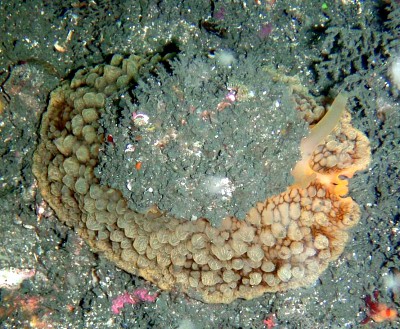
This animal was found in about 17m of water on an underwater rock island west of Bare Island (Sydney), water temp about 19c, 10 Jan 2010.
It has a siphon like a volute, but no shell, and is about 6 cm long. It is doesn't look like a nudibranch either and looks so different to anything I've seen before I don't know where to start looking to try and identify it.
Locality: Bare Island, Sydney, 17m, NSW, Australia, Tasman, 10 January 2010, Silt covered rock outcrop. Length: 6 cm. Photographer: mike burnett.Can you help please?
Thanks.
Mike Burnett
mrburnett@tpg.com.au
Burnett, M.R., 2010 (Jan 19) Not a volute or nudibranch?. [Message in] Sea Slug Forum. Australian Museum, Sydney. Available from http://www.seaslugforum.net/find/23105Dear Mike,
This is a primitive sea slug called Umbraculum umbraculum. If you have a look at the Fact Sheet, and the messages attached to that page, you will see photos which show many aspects of its anatomy and biology. It does have a shell - it is round and flattened and sits on the top of the animal. In your photo it is covered in sea weed and associated mud and silt. There is a large gill hidden under the right side of the shell and until recently Umbraculum and its relative Tylodina were considered the most primitive of the side-gilled slugs or pleurobranchs, which also have a gill on the right side, but we now think they are two unrelated groups.
Also the siphon you can see is in fact one of a pair of head tentacles. You are right to compare it with the siphon of carnivorous snails like the volutes, because like their siphon it is a hollow enrolled tube used to suck water into the mantle cavity and gills. While their primary function is to provide oxygen rich water to the gills, the water also passes over sensory regions so that both animals can 'smell' chemicals in the water which can lead them to their food.
Best wishes,
Bill Rudman
Re: Old slug from Guyana
December 23, 2009
From: Floris Bennema
Concerning message #22808:
Hello Bill,
I'll give you some more information about the book. It is an 18th century work, for the main part describing species along the Dutch coast. As I told this specimen was send to the author from Guyana.
The book is Dutch: Natturlijke Verlustigingen from Martinus Slabber (1769-1778).
http://www.coastsandreefs.net/books/nv/nv.php
In the (Dutch) text the author seems unaware of any shell.
I got the suggestion that it could be an abalone (Haliotis) without a shell. Perhaps this could explain the papillae on the sides, I am not sure limpets have these as well.
Floris Bennema
f.p.bennema@gmail.com
Bennema, F. B., 2009 (Dec 23) Re: Old slug from Guyana. [Message in] Sea Slug Forum. Australian Museum, Sydney. Available from http://www.seaslugforum.net/find/22976Thanks Floris,
Some limpets do have papillae a bit like illustrated and I did wonder about Haliotis. The biggest problem is not knowing how accurate the illustrations are. For example the three pairs of head tentacles are a puzzle. I am afraid that without a specimen we can only guess.
Best wishes,
Bill Rudman
Old slug from Guyana
November 25, 2009
From: Floris Bennema
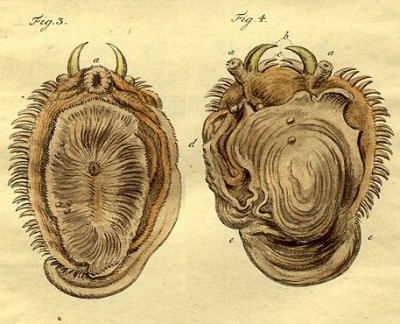
Hi,
I am studying species in an 18th century book and ran in to this slug.
It was send to the Dutch author ('in liqour') from Esseqiubo, a Dutch colony in Guyana (South America; West Atlantic)
Locality: Unknown, unknown, Guyana, West Atlantic ocean, 1765, unknown. Length: 3/4 of a thumb (= 2 cm.). Photographer: Martinus Slabber.
According to the author it is a sea slug. In 1970 a Dutch malacologist (van Benthem Jutting) speculated it could be a Umbraculum, but she was doubtful.
Does anyone have an idea?
Thanks
Floris Bennema
f.p.bennema@gmail.com
Bennema, F.P., 2009 (Nov 25) Old slug from Guyana. [Message in] Sea Slug Forum. Australian Museum, Sydney. Available from http://www.seaslugforum.net/find/22808Dear Floris,
It would be valuable if you could give me the name of the book and author to include with your message.
The first problem is we have no idea just how accurate the artist [or engraver] was. It certainly could be a snail or slug with a limpet-shaped shell and there are indications it could be Umbraculum, but if the frilly row of papillae are suppose to represent the single gill of Umbraculum, then the papillae should run above the head and tentacles in an unbroken row. Also if you look at some of the photos of Umbraculum you will see that the head and 'snout' are not as in this illustration. Another possibility is another limpet-like slug, Tylodina americana. I don't have any photos on the Forum but have a look at Tylodina corticalis which has a head more similar to the illustration.
The other possibility is that it is some type of limpet. I'm afraid I can't easily identify the 3 pairs of tentacles [a,b,c]. Perhaps they are not accurate? Are shells illustrated in the book? I suspect if it had a shell it would have dropped off in the 'preserving jar' and if it didn't dissolve in the 'liqour' perhaps it was dried and drawn separately?
Best wishes,
Bill Rudman
Re: Umbraculum laying eggs
January 29, 2009
From: Leanne and David Atkinson
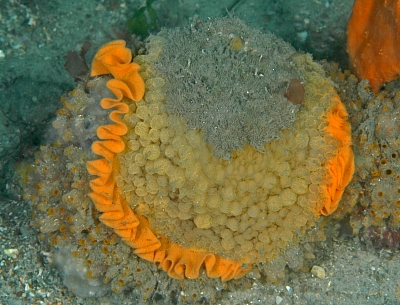
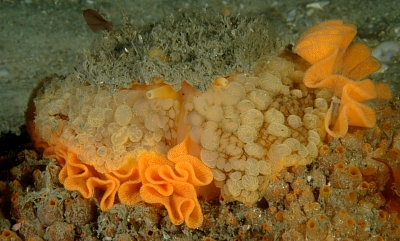
Concerning message #9626:
Hi Bill,
The bright orange of the eggs attracted my attention to this large Umbraculum umbraculum laying eggs. It was completely encircled with its own eggs. We know we have already sent in some egg laying shots but thought this might still be of interest.
Locality: The Pipeline, Nelson Bay, Port Stephens , 10metres, New South Wales, Australia, Pacific Ocean, 09 January 2009 , Sandy bottom sponges, bryozoans, soft corals, hydroids and ascidians. Length: 160 mm. Photographer: Leanne and David Atkinson.
Regards,
Leanne & David Atkinson
atk@hunterlink.net.au
Atkinson, L. & D., 2009 (Jan 29) Re: Umbraculum laying eggs. [Message in] Sea Slug Forum. Australian Museum, Sydney. Available from http://www.seaslugforum.net/find/22155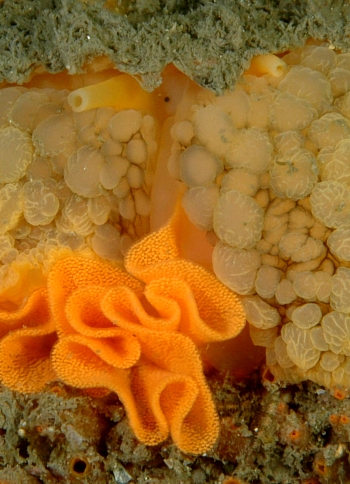
Dear Leanne and David,
Photos of animals 'doing things' are always welcome, and it especially valuable to get another photo of Umbraculum egg-laying. As you imply from your message, the bright colour of the egg certainly draws attention to the animal. What is just as remarkable is just how camouflaged in colour and texture the animal is on what is apparently its food sponge. The growths covering the shell complete the illusion that Umbraculum is just part of a sponge colony.
Best wishes,
Bill Rudman
Juvenile Umbraculid? from North Sulawesi
October 8, 2008
From: Hösel, Heidi
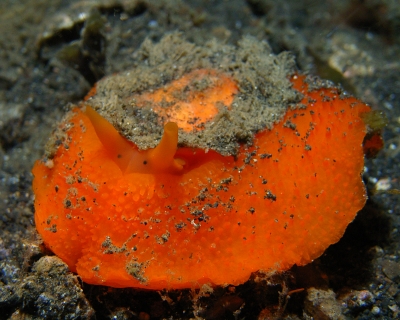
Dear Dr. Rudman
This specimen was found during a night dive, at Jahir 1, a typical muck dive site in the Lembeh strait. I was puzzled by the skin colour and texture, with only small papillae. When I checked the records in your forum about Tylodina and Umbraculum species I found nothing comparable. Having regard to the species list, I now assume that this nudibranch with an approximate size of 8 cm is a juvenile form of Umbraculum umbraculum.
could you please help me to identify it?
Locality: Lembeh Strait , about 6m, North Sulawesi, Indonesia, w-Pacific, 17 August 2007, black sand. Length: 8cm. Photographer: Heidi Hösel.
Heidi Hösel
hhoesel@gmx.de
hösel, H., 2008 (Oct 8) Juvenile Umbraculid? from North Sulawesi. [Message in] Sea Slug Forum. Australian Museum, Sydney. Available from http://www.seaslugforum.net/find/20904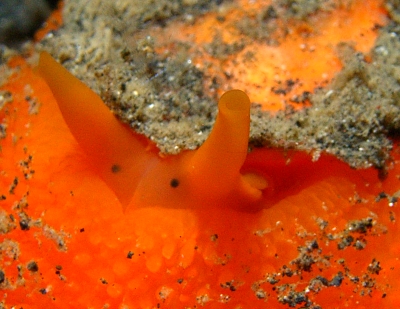
Dear Heidi,
Yes this is Umbraculum umbraculum. They have a considerable range in colour from pale translucent whitish, through yellow, to bright orange. Often their are large whitish pustules but sometimes like your animal, the pustules are smaller and the same colour as the rest of the body. I suspect the colour of individuals is associated with the colour of the sponges they are feeding on, perhaps through the transfer of sponge pigments to the Umbraculum, but that is an idea, not a Fact!
Best wishes,
Bill Rudman
Umbraculum umbraculum from New Zealand
December 8, 2006
From: Kent Ericksen
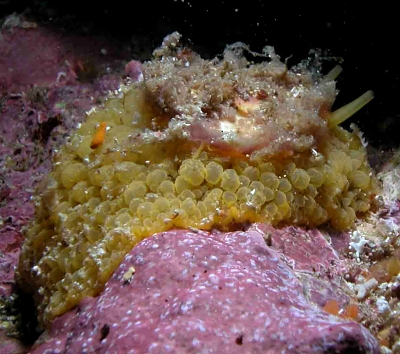
Dear Bill
I found this at about 12 metres inside Blue Maomao Archway, Poor Knights Islands, NZ, during the day 4 December 2006. It is approximately 50 mm in length and appeared to be headed for two clown nudibranchs about 300 mm away.
Locality: Blue Maomao Archway, Poor Knights Islands, 12 metres, New Zealand, Pacific Ocean, 04 December 2006, Mid-morning, archway 16 - 6 metres depth. Length: 50 mm. Photographer: Kent Ericksen.
It looks like a nudibranch - maybe some kind of Dorididae - but I've exhausted all my references. It seems to be 'carrying' something odd on its back.
Can you ID it for me?
Kind regards
Kent
kentericksen@hotmail.com
Ericksen, K.H., 2006 (Dec 8) Umbraculum umbraculum from New Zealand. [Message in] Sea Slug Forum. Australian Museum, Sydney. Available from http://www.seaslugforum.net/find/18952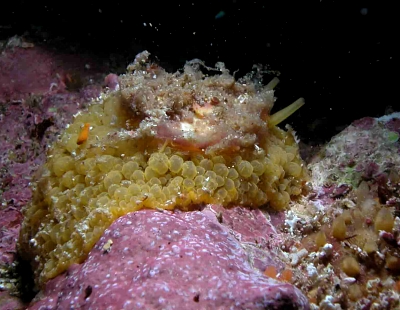
Dear Kent,
This is Umbraculum umbraculum, a strange primitive sea slug with few close living relatives. It is not a dorid nudibranch and was long thought to be related to the pleurobranchs or side-gilled slugs because like them it has a large single gill on the right of the body. However recent studies suggest it and Tylodina are more closely related to the nudibranchs than the pleurobranchs.
The structure which puzzles you on its back is its umbrella-shaped shell, from which it gets its name. Have a look at an ealrier message from New Zealand [#12844] where I label some of the basic parts of this animal. And of course look at the species Fact Sheet and the other messages attached to that page.
The orange 'blob' you can see on the back of the animal, behind the shell, is faecal material. Not perhaps a 'polite society' topic but a good clue to its diet of a group of sponges of a similar colour. Although very obvious when out in the open, Umbraculum can squeeze itself into some most unlikely crevices, and sometimes into cavities it has eaten in a large sponge colony. In these situations, its dull coloured warty back, and the shell, covered in plant growths, render it almost invisible. In the photo alongside it looks as though there is a second half-hidden animal at the bottom right corner, looking a bit like a contracted sea anemone.
Best wishes,
Bill Rudman
Umbraculum umbraculum from Reunion Island
December 8, 2006
From: Hugues Flodrops
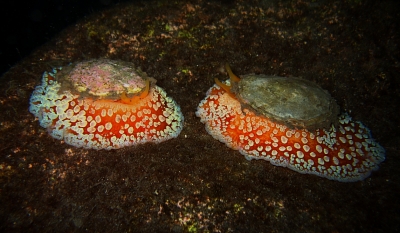
Concerning message #16583:
Dear Bill,
I found yesterday three specimens of Umbraculum umbraculum, with Philibert Bidgrain (Reunion Seaslug site). The first one [lower right photo] was the biggest we have ever seen (180 mm), and the others were relatively standard(140 mm). We can see the mouth in middle left photo. It seems a good season to find them.
Locality: Etang-Salé, Côte Rocheuse, 0,5 metre, Reunion Island, Indian Ocean, 28 November 2006. Length: 180 mm and 140 mm. Photographer: Hugues Flodrops.
Regards.
Hugues
hugues.flodrops@wanadoo.fr
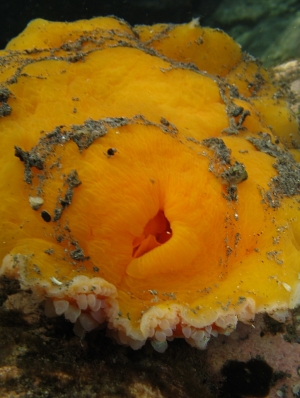
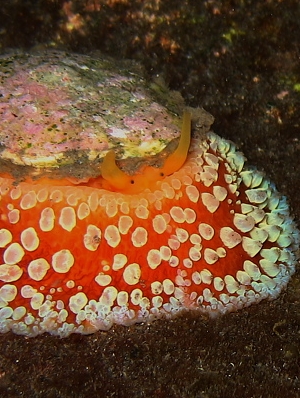
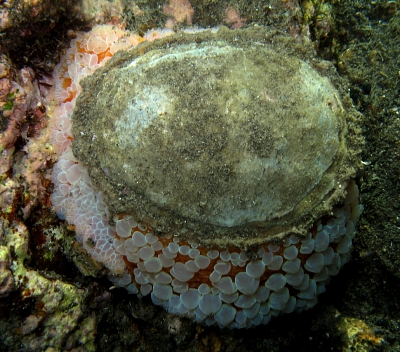
Thanks Hugues,
I guess the sizes you give are shell lengths? It is interesting how your animals seem to be without any growths on the shells, while in some parts of the world the shell is always covered in algae and colonial animals. Thanks for the photo of the mouth [middle left photo]. I have added a close-up [middle right] to show the front of the body. You would expect the mouth to be up near the eyes and head tentacles [rhinophores] which can be clearly seen at the top of the body, but in this strange animal the mouth is far away on the sole of the foot. Running down the front of the body, from the eyes to the mouth, is a deep vertical groove, which contains the openings of the reproductive system
Best wishes,
Bill Rudman
Umbraculum from the Gold Coast, Queensland
May 12, 2006
From: Ian Banks
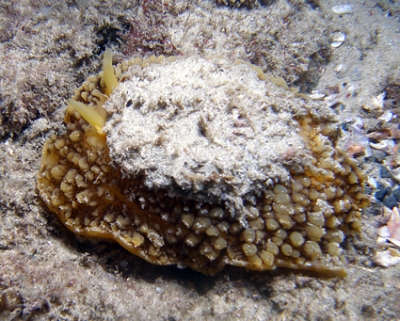
Bill,
Found this out wandering near the sand pipe in the Gold Coast Seaway, sand wouldn't rub off top to obtain a better photo, so I took an underside photo to hopefully aid in the ID process.
Locality: Seaway South Wall, Gold Coast, 7 metres, South East Queensland, Australia, Pacific Ocean, 8 May 2006, Seaway floor. Length: 50 mm. Photographer: Ian Banks.
Regards,
Ian
ianbanks@bigpond.com
Banks, I.W., 2006 (May 12) Umbraculum from the Gold Coast, Queensland. [Message in] Sea Slug Forum. Australian Museum, Sydney. Available from http://www.seaslugforum.net/find/16583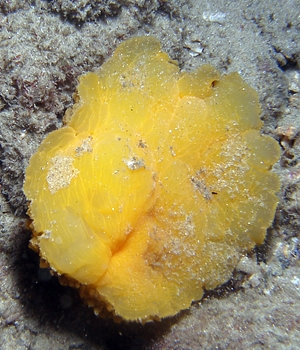
Dear Ian,
I am glad you didn't try too hard to rub off the sand because this is Umbraculum umbraculum which is a rather primitive slug with a round limpet-shaped shell in the middle of its back. What you were trying to rub off was the sand and growths that often accumulate on its shell.
Best wishes,
Bill Rudman
Umbraculum umbraculum feeding
March 25, 2006
From: Leanne & David Atkinson
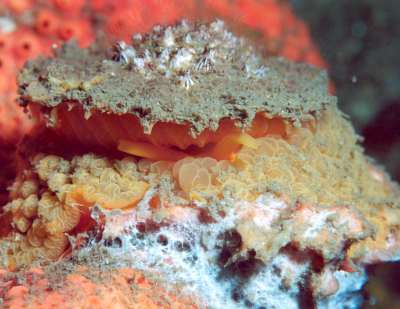
Dear Bill,
You asked for some photos of Umbraculum umbraculum feeding. We thought these were feeding. When we find them they are frequently on these orange barrel sponges both at Fly Point and Halifax sponge gardens. They blend in well with the texture and colour of the sponge. We see them less frequently at The Pipeline where there are fewer orange barrel sponges.
They often end up, we presume, eating a hole into the sponge and become buried in the hole, which makes it difficult to see if they are actually feeding. Attached is a photo of one buried in a sponge. We've also included a long shot to show more of the structure of the sponge.
Locality: Fly Point Marine Reserve Port Stephens, 14 metres, New South Wales, Australia, Pacific, 31st January 2004, Sandy bottom many sponges soft corals ascidians and bryozoans. Length: 120 - 200 mm. Photographer: Leanne & David Atkinson.
Regards,
Leanne & David Atkinson
atk@hunterlink.net.au
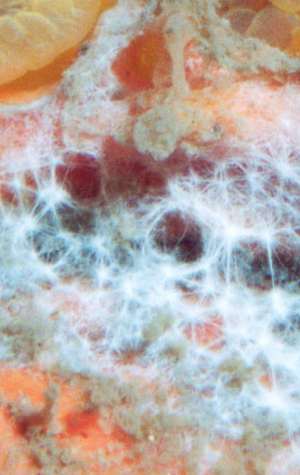
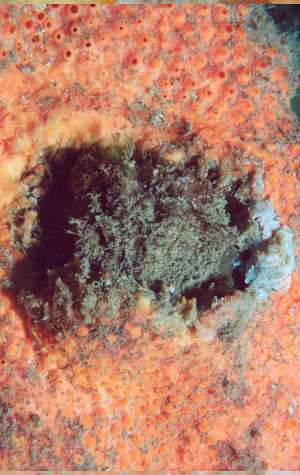
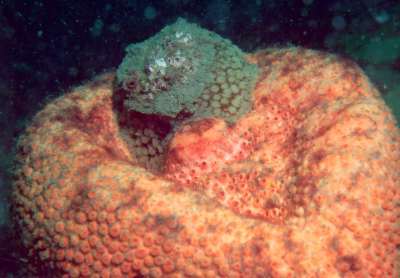
Dear Leanne & David,
Thanks for these interesting photos. I am not sure of the identity of your sponge, but in New Zealand they feed on a variety of spiculate sponges such as Aaptos, Tethya and Ancorina. The white material at the edge of the sponge 'wound' looks interesting. It looks like the skeletal stucture of spongin and siliceous spicules which hold the sponge body together. I don't knonw if this means Umbraculum has regurgitated this or what. My understanding was that the slug bit or scraped off chunks of sponge and swallowed them undigested. I certainly have seen its faecal pellets which consist mainly of nicely arranged bundles of sponge spicules, showing that it certainly eats some sponge material whole.
If you have any clues where the white material comes from I would be interested
Best wishes,
Bill Rudman
Umbraculum umbraculum from Port Stephens
March 10, 2006
From: Bruce Potter
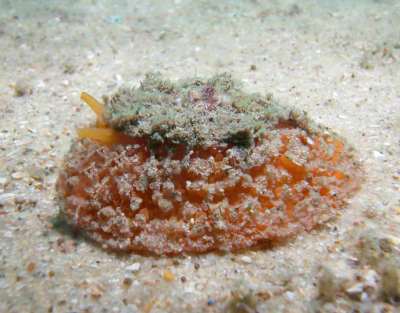
Dear Bill,
I have seen several examples of Umbraculum umbraculum in Nelson Bay, but they have all been large animals down in rocky crevices or among sponges where photographs did not come out at all well. This morning I found this small specimen (40 mm) out and about, and was able to get a nice shot of it.
Locality: Nelson Bay, 11 meters, NSW, Australia. Pacific, 05 March 2006, Sandy, with rocks sponges algaes etc. Length: 40 mm. Photographer: Bruce Potter.
Regards
Bruce Potter
bandppotter@bigpond.com
Potter, B., 2006 (Mar 10) Umbraculum umbraculum from Port Stephens. [Message in] Sea Slug Forum. Australian Museum, Sydney. Available from http://www.seaslugforum.net/find/16038Dear Bruce,
Yes it is not often that you see a large specimen out in a 'posing' position. If you see one feeding, I wouldn't mind some photos of one in action.
Best wishes,
Bill Rudman
Re: An aquarium 'hitch-hiker'
November 18, 2005
From: Unni Nair
Dear Bill,
Thanks a lot for the ID [message #15248]
Unni
manjunni@yahoo.com
Nair, U., 2005 (Nov 18) Re: An aquarium 'hitch-hiker'. [Message in] Sea Slug Forum. Australian Museum, Sydney. Available from http://www.seaslugforum.net/find/15255An aquarium 'hitch-hiker'
November 12, 2005
From: Unni Nair
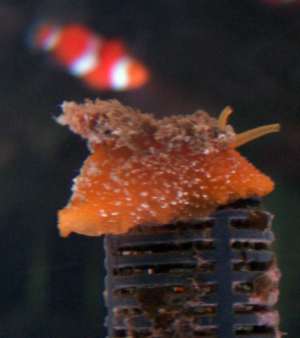
It crawled out of the live rock (from Fiji) in my saltwater aquarium.
Length: 1- 1.5 inch. Photographer: Unni Nair
Unni Nair
Virginia, USA
manjunni@yahoo.com
Nair, U., 2005 (Nov 12) An aquarium 'hitch-hiker'. [Message in] Sea Slug Forum. Australian Museum, Sydney. Available from http://www.seaslugforum.net/find/15248Dear Unni,
It's surprising what survives in 'live rock'. This is a 'side-gilled' slug called Umbraculum umbraculum. You'll see form the Fact Sheet that it has a flattened conical shell, often covered in plant growths, as in your animal. It is obviously a juvenile.
Best wishes,
Bill Rudman
Umbraculum umbraculum from New Zealand
December 30, 2004
From: Trevor Edward Lochore

Photographed in Matauri Bay, Northland, I have enquired within New Zealand as to what species this is ..unknown. We are keen to know exactly what this is..we thought at first it could be an anenome of sorts, then after 10 minutes observation realised it wasn't .. could it be an egg pouch? As you can see, its in tight with the Stayfast Kelp - we are really interested...can you help us?
Locality: Matauri Bay, Northland, New Zealand
Depth: approx 7 metres. Length: 6 inches in length, February, 2004
rocky topography
Photographer: Trevor E. Lochore
and a merry xmas to you by the way,
Bev and Trev
Bev-trev@xtra.co.nz
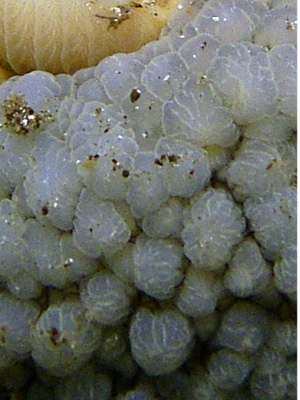
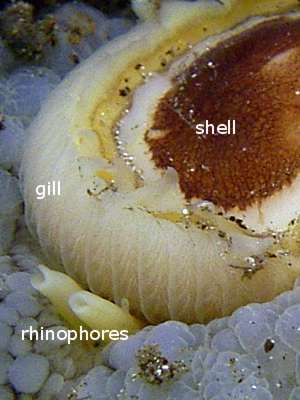
Dear Trev,
This is the primitive side-gilled slug, Umbraculum umbraculum. It looks quite like the Wandering Sea Anemone, Phlyctenanthus australis, which is often found attached to kelp, here in New South Wales. I am pretty sure there is a similar, if not the same anemone in New Zealand. It also looks very like the large dorid nudibranch Archidoris wellingtonensis, which is definitely found in New Zealand. However its closest relatives are the side-gilled slugs such as Pleurobranchus and Pleurobranchaea. If you look at Paul Furneaux's message [#10615] concerning Pleurobranchaea maculata from New Zealand, you will see from the photos why they are called side-gilled slugs.
I have included a couple of close-ups from your photo to show the large external limpet-like conical shell, and the large gill which lies under the shell arround the front and down the right side of the body. Usually the gill is hidden under the shell, but when the animal is feeling safe, it can extend the gill out from under the shell as in your photo [lower right]. The whole body is covered in conical pustules as can be seen in your lower left photo.
Best wishes,
Bill Rudman
Umbraculum umbraculum from Jervis Bay
November 27, 2003
From: Sue Newson
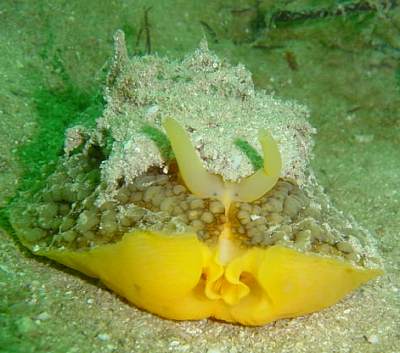
Hi Bill,
I came across an Umbraculum umbraculum today and thought you would like this photo for your Forum.
The site where it was found is not a dived area, although I dived it 3 times over the weekend. Two night dives and a day dive.
The bottom composition is silt with small coral trees, clumps of ascidians, sargassum trees as well as a few scallops. It has a depth of 12m and flat.
Location - Jervis Bay (southern side)
Depth 12m
Water Temp - 18*C
Time - 11am
Date - 24th November 2003
Sue Newson
snewson@shoal.net.au
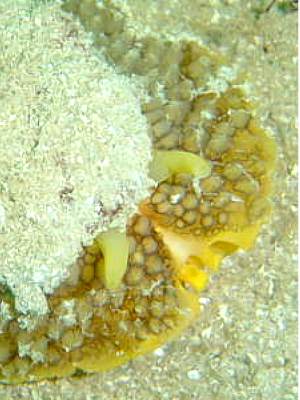
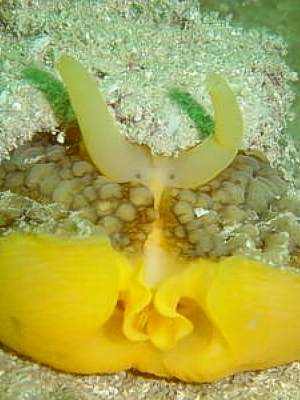
Dear Sue,
Thnaks for the interesting and unusual view of the head of Umbraculum. As I have said before, our knowledge of the external shape of the head region is based on the dissection of preserved animals and unfortunately when they are preserved they tend to contract and the muscular bosy wall becomes stiff and rigid, making interpretation of the anterior structures very difficult. I can find no intelligible drawings showing these features. In your photo the pair of yellow flaps which are joined to form a tube in the midline are oral flaps or tentacles on either side of the mouth.
Best wishes
Bill Rudman
Umbraculum laying eggs
April 10, 2003
From: Leanne & David Atkinson
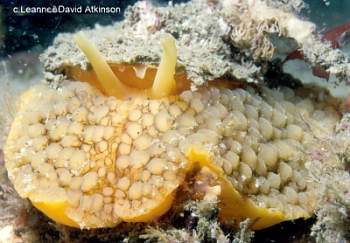
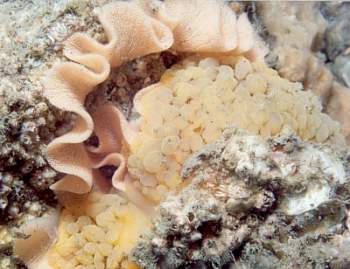
Dear Bill,
We just read the message by Dee Scarr re the Umbraculum mating. Umbraculum are quite common at Port Stephens. We often see them on large orange barrel sponges where they are well camouflaged. We managed to catch one laying eggs and thought you might like to add it to the site. We've also included a "face" shot. The egg layers details are as follows:
Location: Fly Point, Marine Reserve, Port Stephens, NSW, Australia.
Date: 22 September 2001. Time: 12:16pm
Tide: High 1.6m Water Temp.: 18 degrees C.
Depth: 12m
Regards,
Leanne & David Atkinson
atk@hunterlink
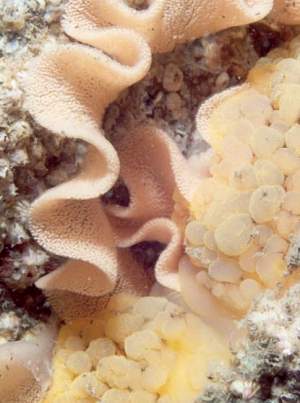
Dear Leanne & David,
Thanks for filling another gap. In fact in your close-up alongside I can see a very interesting thing. If you look carefully at where the egg ribbon is emerging you can see it is coming out of a flap of tissue which has previously been identified as a permanent external penis. [see earlier photos]. It looks here as though this structure may be related to similar flaps of tissue found at the genital opening of the pleurobranchids, rather than being a penis. I'm afraid some anatomical structures are very difficult to interpret in preserved, often distorted animals. In the case of Umbraculum the structures at the front of the body lie in a groove in the extremely muscular body wall. When tha animal is preserved, the muscles of the body wall contract - even if the animal is 'put to sleep' first - so it is almost impossible to see this region clearly. All we need now is someone - an intrepid naturalist/diver - to gently pull two mating animals apart to see just what goes where during mating.
Best wishes,
Bill Rudman
Umbraculum umbraculum from Lord Howe Island
January 21, 2003
From: W.B. Rudman
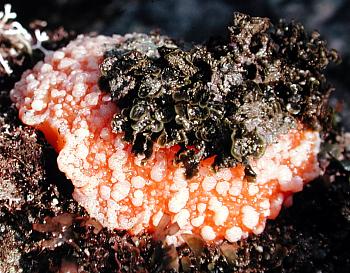
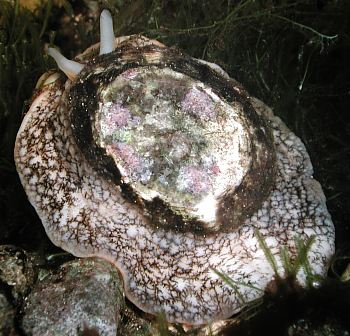
Here is a photo record from Ian Hutton of Umbraculum umbraculum from Lord Howe Island.
Location: Neds Beach.
Bill Rudman
Rudman, W.B., 2003 (Jan 21) Umbraculum umbraculum from Lord Howe Island. [Message in] Sea Slug Forum. Australian Museum, Sydney. Available from http://www.seaslugforum.net/find/8990Umbraculum umbraculum from Indonesia
January 6, 2003
From: Mary Jane Adams
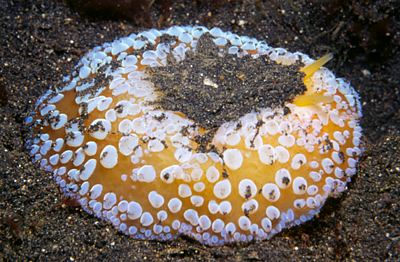
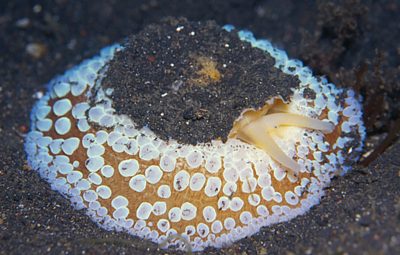
Hi Bill,
Here are some images of Umbraculum umbraculum from Lembeh Strait, Sulawesi Island, Indonesia.
I photographed the upper one on a night dive on a silty sand slope called Hairball in August, 200l. I shot the other two images on the night of November 20, 2002, at the same divesite. Both animals were about 15cm long and about 5 meters deep. Although I photographed them 15 months apart, I suspect they are the same specimen. In the Nov. 2002 picture the shell is elevated, revealing the eyespots and a bit of the gills.
Best regards,
Mary Jane
divepng@yahoo.com
Adams, MJ., 2003 (Jan 6) Umbraculum umbraculum from Indonesia. [Message in] Sea Slug Forum. Australian Museum, Sydney. Available from http://www.seaslugforum.net/find/8715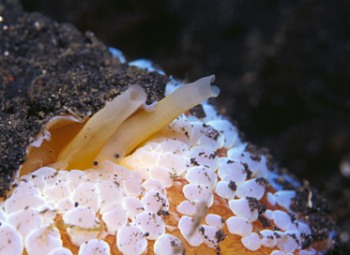
Thanks Mary Jane,
The eyes and the typically rolled rhinophores are clearly visible in your photo alongside
Bill Rudman
Umbraculum what?
December 21, 2001
From: Valda Fraser
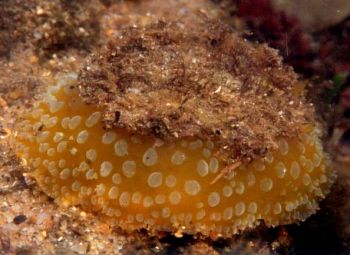
Dear Bill
My references do not give the same name. What is the latest?
Locality: Pumula, south coast KwaZulu-Natal, South Africa, intertidal zone
Date: December 2001
Size: 90 mm
Thanks.
Regards
Valda Fraser
valdafraser@mweb.co.za
Fraser, V., 2001 (Dec 21) Umbraculum what?. [Message in] Sea Slug Forum. Australian Museum, Sydney. Available from http://www.seaslugforum.net/find/5871Dear Valda,
The prevailing view is that there is one species in the Indo-West Pacific and its earliest name is Umbraculum umbraculum.
Best wishes,
Bill Rudman
Umbraculum from Sydney Harbour.
July 4, 2001
From: George Evatt
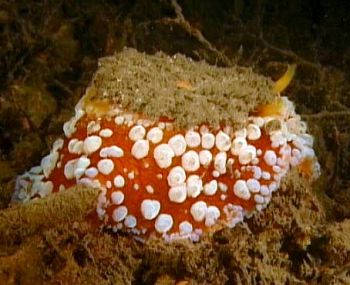
Hi Bill,
I took this picture at Clifton Gardens in Sydney Harbour [NSW, Australia] the other night. I have not seen this animal before and I can't find it in any book I have, it was about 12cm long.
Do you know what it is?
Regards
George Evatt.
coralsea@intercoast.com.au
Evatt, G. , 2001 (Jul 4) Umbraculum from Sydney Harbour.. [Message in] Sea Slug Forum. Australian Museum, Sydney. Available from http://www.seaslugforum.net/find/4739Dear George,
This is a very brightly coloured example of Umbraculum umbraculum. It looks very much the same in colour to a photo I have at the top of the page from Tanzania. In eastern Australia, at least, this species can be found from the intertidal to a depth of at least 274 meters where it is completely colourless.
Best wishes,
Bill Rudman
Umbraculum laying eggs in New South Wales
March 11, 2001
From: Peggy Cable
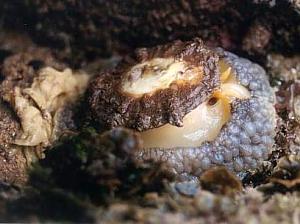
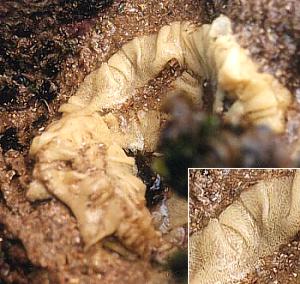
I was on a Coast Care rockplatform walk with a group of people at Shelley Beach, Central Coast, New South Wales in January 2001. We were lucky to find Umbraculum umbraculum sitting on it's eggs. One of the members of our group, Ross Willis, was able to take some photos. He wondered why it was called an 'umbrella shell' until this one started lifting its shell and indeed looked for all the world like an umbrella.
Sincerely
Peggy
cablesdb@tac.com.au
Cable, P., 2001 (Mar 11) Umbraculum laying eggs in New South Wales. [Message in] Sea Slug Forum. Australian Museum, Sydney. Available from http://www.seaslugforum.net/find/3894Dear Peggy,
Thanks for thinking of the Forum, and thanks to Ross for taking the photos. Tom Thompson (1970) reported some facts and figures about an egg mass produced by a 16cm long animal from N. Stradbroke Id, Queensland. The uncoiled ribbon was 100cm long and 22mm high. The number of egg capsules per cm was 46,000 and there were on average 37 eggs in each capsule. This gave a grand total of over 4.5 million eggs in the whole ribbon. Hartley (1964) also published an account of egglaying and early development.
It never ceases to amaze me that this species can be found from the intertidal to 274 meters deep. One advantage of photographing the animal out of water is that you can see parts of its anatomy which are normally hidden by the shell. In the upper photo the umbrella-like shell is lifted to expose the smooth pale coloured cavity which is usually filled with water and encloses the gill which lies along the right side of the body. In this photo the gill is still hidden beneath the shell. I have also included an enlarged version of this photo showing the head region and its anatomy in a separate message.
Thanks again for this interesting find,
Best wishes,
Bill Rudman
References:
• Hartley, T.W. (1964) Egg laying and early development of Umbraculum sinicum Gmelin. J. Mal. Soc. Aust., 8(15 December): 33-35.
• Thompson, T.E. (1970) Eastern Australian Pleurobranchomorpha (Gastropoda, Opisthobranchia). Journal of Zoology, London., 160: 173-198.
Anatomy of Umbraculum
March 11, 2001
From: Bill Rudman
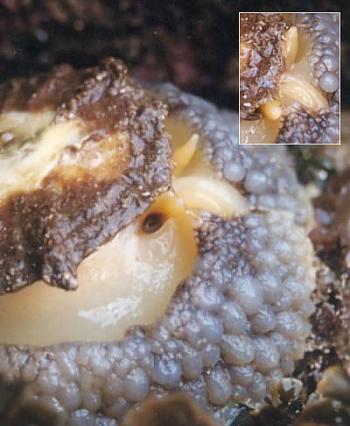
Ross Willis's photos of intertidal Umbraculum out of water show a very good view of the organs around the head, so here is an enlarged view.
With the shell lifted up, the 'pallial' cavity or gap between the shell and the body, is clearly visible. It runs all around the body and is normally filled with sea water. On the right side, it houses the single gill - which still hidden in this photo. Also of interest in these photos are the structures around the head. There are a pair of short enrolled head tentacles or rhinophores, and between them a third organ which looks a bit like the siphon you would see in a sea snail. This is in fact the penis, which in Umbraculum sits in the midline just above the mouth. The dark brown pit at the base of the right rhinophore is a chemosensory organ, sensing chemicals in the water current being drawn down into the pallial cavity by the rhinophores. It is called the Hancock's Organ.
This is quite an interesting view of Umbraculum which we don't usually see until we are dissecting a dead preserved specimen.
Best wishes,
Bill Rudman
Umbraculum umbraculum
June 11, 2000
From: A.Lumnitzer & D.Piotrowska
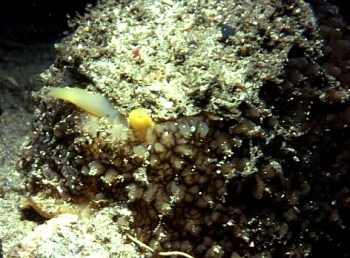
Dear Bill,
Here is a picture of Umbraculum umbraculum for your use from Shiprock, Port Hacking River in Sydney. The animal was about 10cm in diameter. It was in 16m of water on a night dive.
Actually we found Shiprock an excellent location to observe these shells.
Regards
Akos & Donata
dna72@softhome.net
Lumnitzer, A. & Piotrowska, D., 2000 (Jun 11) Umbraculum umbraculum. [Message in] Sea Slug Forum. Australian Museum, Sydney. Available from http://www.seaslugforum.net/find/2542Dear Akos & Donata,
Thanks for the photo. If you have photos of Umbraculum laying eggs or eating a sponge, or get the opportunity to take some, they would be very interesting.
Best wishes,
Bill Rudman.
Re: Mystery from South Africa
August 26, 1999
From: Johan Bresler
Hi Bill,
You have got it right from the Tanzanian picture on the Web site. Looks like my sponge's day's are numbered. Will they accept substitute foods or should I return them to the ocean?
Many Thanks.
Johan Bresler
jbresler@global.co.za
Bresler, J., 1999 (Aug 26) Re: Mystery from South Africa. [Message in] Sea Slug Forum. Australian Museum, Sydney. Available from http://www.seaslugforum.net/find/1248Dear Johan,
I think they are very specialised in their choice of food, and in my experience the sponges they feed on don't survive well in aquaria. Personally, if you can put them back where you collected them, I would do that. Although it might sound a bit strange, one interesting thing to look at are the faecal pellets of Umbraculum. I have never seen it described in the literature, but specimens I looked in New Zealand suggested some sophisticated sorting was going on in the stomach. Each faecal pellet consisted of many bundles of sponge spicules, all packed together into a cylinder. Each spicule bundle consisted of a neatly stacked cluster of spicules arranged like a neat pile of firewood, the spicules all about the same length, each bundle in a little mucous case. Along the edge of the faecal pellet were four or five streaks of orange or yellow which I presume was the waste from the sponge tissue. Somehow the digestive system sorts out the spicules and stacks them into neat bundles, then wraps each bundle in a mucous sac, then packs a number of bundles to make a faecal pellet.
Best wishes,
Bill Rudman.
Mystery from South Africa
August 25, 1999
From: Johan Bresler
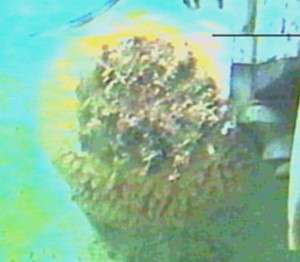
I have found 2 Nudibranchs that looks like wandering oval bubble corals. They have a yellow base with white bubbles - like coral bubbles all over their bodies. They have a smaller spot on the middle of their backs that looks like marine rock. Any ideas on what species this may be?
These slugs have been found on the Sub-Tropical KwaZulu-Natal coast of South Africa in a Tidal Pool area. In the Aquarium they snuggle in under the sand every now and then. They also snuggle in under the sand together. The have antennae on the front end of their bodies. I detect no stress or deterioration in their condition at this stage.
Johan Bresler
jbresler@global.co.za
Bresler, J., 1999 (Aug 25) Mystery from South Africa. [Message in] Sea Slug Forum. Australian Museum, Sydney. Available from http://www.seaslugforum.net/find/1242Dear Johan,
I'm afraid the 'grab' from your video doesn't give me much help, but I think from your description you have found a couple of Umbraculum umbraculum. Have a look at the photos at the top of the page. These are not nudibranchs, but they are Sea Slugs, belonging to a separate Order, the Notaspidea, sometimes called the Side-gilled Slugs.
If my identification is correct, the 'marine rock' on their backs is in fact their shell, which is often overgrown with other marine life. Let us know if I have guessed correctly.
In future I am happy to look at real photos, but I suspect for most slugs, video frame grabs won't give me enough information even for a guess.
Best wishes,
Bill Rudman.
Umbraculum from deep water off Australia
March 25, 1999
From: Bill Rudman
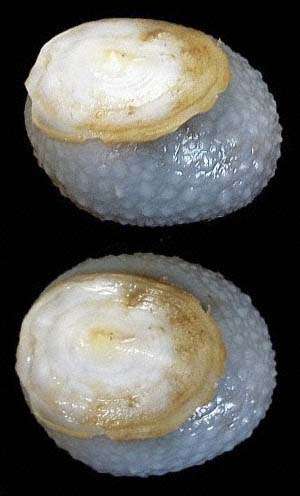
Yesterday we received a frozen Umbraculum umbraculum from 203m from off the southern part of the Great Barrier Reef. It was sent by Alan Limpus, a well known shell-collector, who thought it rather unusual. The photos I have taken of the freshly dead animal (Shell length = 7cm) show its translucent white colour.
I know of no published records of such deep water specimens of Umbraculum umbraculum, an animal normally considered to live intertidally or in scuba depths. In the Australian Museum, we have records of dredged specimens from off southern New South Wales at depths ranging from 30 to 274m, suggesting it is widely distributed across the continental shelf. The deeper water specimens are all very pale coloured. Perhaps the colour of the animals is dependant on pigments obtained from their food sponges? Intertidal Umbraculum range from bright orange to yellow and dull brown. Perhaps the deeper water sponges it is eating are often pale or colourless?
The full locality details are: 25 miles East of the Swains Reefs, Great Barrier Reef, Queensland, Australia. 203m Trawled by FV Nelissa Jay, March 1999. Presented by Alan Limpus. (Photos: Bill Rudman)
Bill Rudman.
Rudman, W.B., 1999 (Mar 25). Comment on Umbraculum from deep water off Australia by Bill Rudman. [Message in] Sea Slug Forum. Australian Museum, Sydney. Available from http://www.seaslugforum.net/find/724